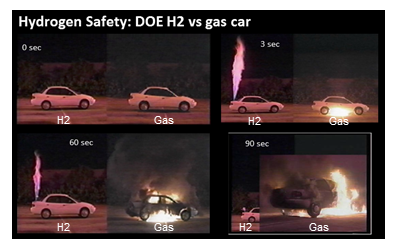Truth is Power: Hydrogen Safety 101
Allow us to debunk the myths about hydrogen safety with real-life evidence.
By Dr. Luke Wentlent

It is no surprise that in recent years eyes have turned to green hydrogen as a core component of helping the world reach net zero. Hydrogen is an energy carrier, which can be produced in a zero-emission, environmentally responsible way using clean, renewable energy. Furthermore, it does not have the same kind of health and safety concerns most fossil fuels have as hydrogen is non-toxic and dissipates rapidly. Not only is green hydrogen sustainable, but hydrogen safety standards are also developed, mature, and effective, according to the Department of Energy.
Experts and regulators agree when handled appropriately, hydrogen is a far safer fuel than those currently in use today, according to Washington State University professor Dr. Jacob Leachman. In fact, the U.S. Department of Energy’s Hydrogen and Fuel Cells Technologies Office stated “a number of hydrogen’s properties make it safer to handle and use than the fuels commonly used today,” including gasoline, natural gas, uranium, jet fuel, and diesel.
Aside from green hydrogen being produced solely from sustainable energy and only emitting harmless water as a by-product when used in a fuel cell, there are an abundance of hydrogen safety features which ensure production, distribution, storage, and utilization is as safe as possible. The safety regulations, summarized here by the Fuel Cell & Hydrogen Energy Administration, are managed by governments, and regulated in accordance with third-party international hydrogen safety standards – making hydrogen a decarbonization solution with a safe, developed technical foundation. These include codes and standards around hydrogen infrastructure, on-road and fueling, first responder practices, fuel cell design, use in marine and aviation applications, and even for use in a fuel cell-powered bicycle.
Despite this reality and the advances which have been made with hydrogen, there are still myths which plague our efforts to decarbonize using a sensible and safe energy carrier like green hydrogen. Let us debunk those fallacies on hydrogen safety with real evidence here.
The Myth: Hydrogen leaks too much.
The Truth:
There is a misconception because hydrogen is the lightest and smallest element, it will leak more than other fuels – but leakage of hydrogen is in fact no different than leakage of natural gas. A 2020 study performed by Mejia, Brouwer, and MacKinnon at the University of California Irvine showed hydrogen leaks from pipes at the same rate as 100% natural gas from a typical low-pressure natural gas distribution pipeline (45 psi gauge pressure). They explained in real world, realistic equipment and scenarios there was no statistical difference in the leakage of pure natural gas, pure hydrogen, or a 90/10 blend of natural gas and hydrogen (respectively).
The Myth: A hydrogen leak is always dangerous.
The Truth:
As the HyResponse consortium explained in their 2013 report, hydrogen is a colorless, odorless, nontoxic and non-poisonous gas – unlike methane and gasoline or diesel – if a leak does happen, it would fortunately not threaten human or environmental health. Other fuel gases, such as propane and gasoline, are heavier than air, allowing leaks to creep along the ground to find a spark. Hydrogen is so light by comparison – 14.4 times lighter than air –it dissipates much more quickly when released. Hydrogen rises in the surrounding air at a speed of 20 meters/second, allowing for rapid dispersion of the fuel in the event of a leak and making it unlikely to remain near the ground where people are in case of fire. This behavior was understood and studied as far back as 1957 by Shapiro and Moffette while working at Westinghouse Electric Corp. In fact, hydrogen is the most diffusive fuel available today, according to HyResponse. If hydrogen is ignited somehow, not only will the fire burn out far faster than an oil or gas fire, but it will also burn up and away. This is one of the built-in safety features of hydrogen, it does not hang around outside of a container, see Figure 1.

The United States Army studied hydrogen fueled vehicles for use on the battlefield and went as far as to strap C4 to the side of the tank to get a full tank explosion. Their report concluded “Storing the hydrogen at pressure will not cause any more significant safety issues than liquid fuel in the event of a ballistic penetration or explosion due to the inherently safe design of the storage systems,” according to Dr. Leachman.
The Myth: Hydrogen safety is not compatible with current infrastructure.
The Truth:
As the industry prioritizes a decarbonization roadmap which is cost-effective for all, there is financial incentive to repurpose the existing natural gas pipelines to transport hydrogen. One concern which is often expressed is compatibility of hydrogen with our existing natural gas pipelines, particularly regarding embrittlement and leakage. However, there are different ways to mitigate these concerns – coating the metal to prevent hydrogen permeation and embrittlement is one example – and researchers are actively looking into innovative solutions. Researchers at the National Fuel Cell Research Center and various commercial companies have identified commercially available coatings which can be applied to existing pipes and reduce leakage rates to effectively zero.
While it is true hydrogen can embrittle various metals it is important to understand this is not a binary phenomenon. While ductility may be reduced, it is not taken to zero and completely lost. Embrittlement itself it not a failure mechanism. Rather, it can contribute to and enable failure mechanisms (i.e., crack initiation and propagation) to occur with greater ease. For a material to fatigue and fail, there needs to be some type of cyclically applied load. In a conventional pipeline, cycling applied load occurs via pressure changes in the contents. Baek et al. have shown that in typical pipeline operations, it would take almost 30 years for fatigue cracks from pressure cycling to create a failure.
It should also be noted the safety concerns which do exist for hydrogen are markedly fewer than those of natural gas. Hydrogen is non-toxic, non-poisonous, and significantly lighter than air, unlike natural gas. The bar for a safe, effective, efficient operation is significantly lower than those for natural gas. Finally, there are safety concerns and degradation of our natural gas pipeline system already at present date. Regardless of injecting hydrogen into them, these assets must be repaired and upgraded to operate effectively.
The Myth: Hydrogen is too difficult to safely store and distribute.
The Truth:
It is a fair assessment to say transporting and distributing hydrogen as a liquid or gas is challenging and must be done with careful safety considerations. However, transportation issues are true of every energy carrier modern society uses today. Natural gas, oil, gasoline, diesel, LNG — all are challenging to transport and distribute, possessing numerous safety risks (arguably greater than hydrogen), according to S&P Global.
The reality is the world has been doing this for over a century. There is a wealth of knowledge with safe transportation and storage of cryogenic liquids and the safe, effective handling of pressurized gas tanks. NASA has used and stored millions of gallons of liquid hydrogen since the inception of the space program over 60 years ago. The practices and safety methods are incredibly well established. Pressurized gases are used in an incredibly large number of industries and settings, the world is well versed in safe handling practices given over a century of experience.
Finally, given the non-toxic, non-poisonous nature of hydrogen, the safety concerns in the event of a leak or failure are dramatically lower than for conventional fossil fuels. How often have you read the news only to hear of another oil tanker running aground, leaking, and contaminating a wide area? All of this is backed up by decades of research and real-world experience. Hydrogen is not any more difficult to store than any other energy carrier and does not possess the same toxicity concerns. It can be produced safely, stored safely, distributed safely, and utilized safely.
Plug Leads in Hydrogen Safety
As an active member of the Center for Hydrogen Safety, Plug has 25 years of experience in the hydrogen industry with an excellent safety record. Our facilities are designed and built to the highest safety standards with automated leak and fire detection, isolation and shutoff with multiple redundant points of control, and we conduct several external-expert safety reviews of the design during the design-build process.
Plug also is proactive in conducting research programs led by industry experts who study the behavior of hydrogen and advances in technology and science which will enable even safer and more effective utilization. For instance, as hydrogen adoption accelerates, Plug is actively investigating new applications which may require updated or refined codes and standards. When an area of concern has been identified (i.e., a customer seeking to store hydrogen in some unsafe way), Plug has not been afraid to stop the project until an appropriate safety assessment can be conducted and a safe, well-engineered resolution identified.
All energy carriers pose some safety risk if handled improperly, it is the nature of trying to store energy. It is important to look at the big picture and net benefit when assessing safety concerns since there is no perfect solution to replacing natural gas and diesel. When strictly following the fire codes, industry standards and best practices have already been developed, hydrogen is safer than other fuels the world heavily relies on.
By taking safety and pipeline integrity issues into proper consideration, hydrogen can also be managed safely. Contact us to learn more about how Plug can help you transition to green hydrogen.
Follow Plug on LinkedIn, Twitter or Facebook for more myth-busting content in the future.
References
1. Office of Energy Efficiency and Renewable Energy. Safety, Codes, and Standards Fact Sheet. s.l. : Department of Energy, 2011.
2. Leachman, Jacob. So Just How Dangerous is Hydrogen Fuel. Hydrogen Properties for Energy Research Laboratory.
[Online] Washington State University, 3 17, 2017. [Cited: 8 9, 22.] https://hydrogen.wsu.edu/2017/03/17/so-just-how-dangerous-is-hydrogen-fuel/.
3. Office of Energy Efficiency and Renewable Energy. Safe Use of Hydrogen. Department of Energy.
[Online] [Cited: 8 9, 2022.] https://www.energy.gov/eere/fuelcells/safe-use-hydrogen.
4. Fuel Cell & Hydrogen Energy Administration. Hydrogen/Fuel Cell Codes and Standards. Fuel Cell Standards.
[Online] Fuel Cell & Hydrogen Energy Administration. [Cited: 8 9, 2022.] http://fuelcellstandards.com/.
5. Hydrogen Leaks at the Same Rate as Natural Gas in Typical Low-Pressure Gas Infrastructure. Mejia, A.H., Brouwer, J. and Mac Kinnon, M. s.l. : International Journal of Hydrogen Energy, 2020, Vol. 45.
6. Shapiro, Z.M. and Moffette, T.R. Hydrogen Flammability Data and Application to PWR Loss-Of-Coolant Accident. Pittsburgh, PA : U.S. Atomic Energy Commission, 1957.
7. Tretsiakova-McNally, S. Hydrogen Properties Relevant to Safety. s.l. : HyResponse, 2013.
8. Flamberg, S., Rose, S. and Stephens, D. Analysis of Published Hydrogen Vehicle Safety Research. Columbus, Ohio : National Highway Traffic Safety Administration, 2010.
9. Baek, U.B., et al. Compatibility and Suitability of Existing Steel Pipelines for Transport of Hydrogen-Natural Gas Blends. Hamburg, Germany : International Conference on Hydrogen Safety, 2017.
10. S&P Global. ESG Industry Report Card: Oil and Gas. s.l. : S&P Global, 2019.
11. NASA. Space Applications for Hydrogen and Fuel Cells. NASA.gov.
[Online] 5 27, 2021. [Cited: 8 9, 2022.] https://www.nasa.gov/content/space-applications-of-hydrogen-and-fuel-cells.
The post Truth is Power: Hydrogen Safety 101 appeared first on Plug Power.